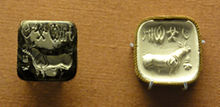The 2nd millennium BC spanned the years 2000 BC to 1001 BC. In the Ancient Near East, it marks the transition from the Middle to the Late Bronze Age. The Ancient Near Eastern cultures are well within the historical era: The first half of the millennium is dominated by the Middle Kingdom of Egypt and Babylonia. The alphabet develops. At the center of the millennium, a new order emerges with Mycenaean Greek dominance of the Aegean and the rise of the Hittite Empire. The end of the millennium sees the Bronze Age collapse and the transition to the Iron Age.

A seal is a device for making an impression in wax, clay, paper, or some other medium, including an embossment on paper, and is also the impression thus made. The original purpose was to authenticate a document, or to prevent interference with a package or envelope by applying a seal which had to be broken to open the container.

Ancient art refers to the many types of art produced by the advanced cultures of ancient societies with different forms of writing, such as those of ancient China, India, Mesopotamia, Persia, Palestine, Egypt, Greece, and Rome. The art of pre-literate societies is normally referred to as prehistoric art and is not covered here. Although some pre-Columbian cultures developed writing during the centuries before the arrival of Europeans, on grounds of dating these are covered at pre-Columbian art and articles such as Maya art, Aztec art, and Olmec art.

Meluḫḫa or Melukhkha is the Sumerian name of a prominent trading partner of Sumer during the Middle Bronze Age. Its identification remains an open question, but most scholars associate it with the Indus Valley civilisation.

The Master of Animals, Lord of Animals, or Mistress of the Animals is a motif in ancient art showing a human between and grasping two confronted animals. The motif is very widespread in the art of the Ancient Near East and Egypt. The figure may be female or male, it may be a column or a symbol, the animals may be realistic or fantastical, and the human figure may have animal elements such as horns, an animal upper body, an animal lower body, legs, or cloven feet. Although what the motif represented to the cultures that created the works probably varies greatly, unless shown with specific divine attributes, when male the figure is typically described as a hero by interpreters.

The Proto-Elamite period, also known as Susa III, is a chronological era in the ancient history of the area of Elam, dating from c. 3100 BC to 2700 BC. In archaeological terms this corresponds to the late Banesh period. Proto-Elamite sites are recognized as the oldest civilization in the territory of present-day Iran. The Proto-Elamite script is an Early Bronze Age writing system briefly in use before the introduction of Elamite cuneiform.
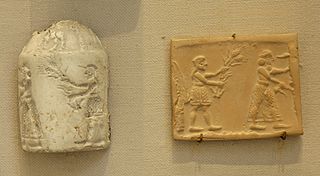
A cylinder seal is a small round cylinder, typically about one inch in length, engraved with written characters or figurative scenes or both, used in ancient times to roll an impression onto a two-dimensional surface, generally wet clay. According to some sources, cylinder seals were invented around 3500 BC in the Near East, at the contemporary sites of Uruk in southern Mesopotamia and slightly later at Susa in south-western Iran during the Proto-Elamite period, and they follow the development of stamp seals in the Halaf culture or slightly earlier. They are linked to the invention of the latter's cuneiform writing on clay tablets. Other sources, however, date the earliest cylinder seals to a much earlier time, to the Late Neolithic period in Syria, hundreds of years before the invention of writing.

Proto-writing consists of visible marks communicating limited information. Such systems emerged from earlier traditions of symbol systems in the early Neolithic, as early as the 7th millennium BC in China and Southeastern Europe. They used ideographic or early mnemonic symbols or both to represent a limited number of concepts, in contrast to true writing systems, which record the language of the writer.
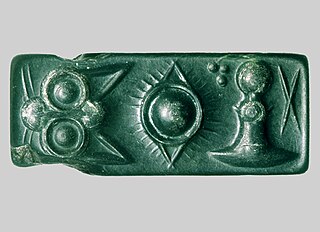
Cretan hieroglyphs are a hieroglyphic writing system used in early Bronze Age Crete, during the Minoan era. They predate Linear A by about a century, but the two writing systems continued to be used in parallel for most of their history. As of 2024, they are undeciphered.
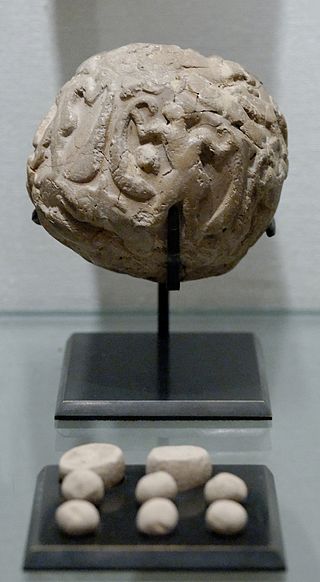
A bulla is an inscribed clay or soft metal or bitumen or wax token used in commercial and legal documentation as a form of authentication and for tamper-proofing whatever is attached to it.

Many undeciphered writing systems exist today; most date back several thousand years, although some more modern examples do exist. The term "writing systems" is used here loosely to refer to groups of glyphs which appear to have representational symbolic meaning, but which may include "systems" that are largely artistic in nature and are thus not examples of actual writing.
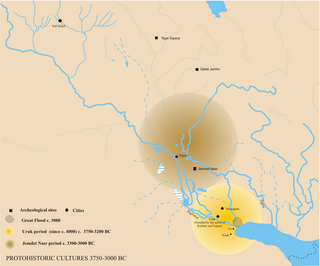
The Jemdet Nasr Period is an archaeological culture in southern Mesopotamia. It is generally dated from 3100 to 2900 BC. It is named after the type site Tell Jemdet Nasr, where the assemblage typical for this period was first recognized. Its geographical distribution is limited to south-central Iraq. The culture of the proto-historical Jemdet Nasr period is a local development out of the preceding Uruk period and continues into the Early Dynastic I period.
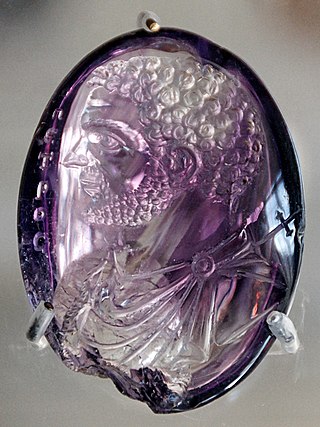
An engraved gem, frequently referred to as an intaglio, is a small and usually semi-precious gemstone that has been carved, in the Western tradition normally with images or inscriptions only on one face. The engraving of gemstones was a major luxury art form in the Ancient world, and an important one in some later periods.

Minoan seals are impression seals in the form of carved gemstones and similar pieces in metal, ivory and other materials produced in the Minoan civilization. They are an important part of Minoan art, and have been found in quantity at specific sites, for example in Knossos, Mallia and Phaistos. They were evidently used as a means of identifying documents and objects.

The art of Mesopotamia has survived in the record from early hunter-gatherer societies on to the Bronze Age cultures of the Sumerian, Akkadian, Babylonian and Assyrian empires. These empires were later replaced in the Iron Age by the Neo-Assyrian and Neo-Babylonian empires. Widely considered to be the cradle of civilization, Mesopotamia brought significant cultural developments, including the oldest examples of writing.

Two main types of seals were used in the Ancient Near East, the stamp seal and the cylinder seal. Stamp seals first appeared in ‘administrative’ contexts in central and northern Mesopotamia in the seventh millennium and were used exclusively until the fifth millennium. Cylinder seals appeared first around 3600 bc in southern Mesopotamia and south-western Iran. They gradually replaced stamp seals, becoming the tool of a rising class of bureaucrats in the early stages of state formation. Even though stamp seals were still produced in the third and second millennia, cylinder seals predominated. In the first millennium, stamp seals made a strong comeback and eventually replaced cylinder seals entirely.

The art of Uruk encompasses the sculptures, seals, pottery, architecture, and other arts produced in Uruk, an ancient city in southern Mesopotamia that thrived during the Uruk period around 4200-3000 BCE. The city continued to develop into the Early Dynastic Period (Mesopotamia) around 2900-2350 BCE. Considered one of the first cities, the site of Uruk – modern-day Warka in Iraq – shows evidence of social stratification, institutionalized religion, a centralized administration, and what art historians would categorize as high art and architecture, the first in the long history of the art of Mesopotamia. Much of the art of Uruk shows a high technical skill and was often made using precious materials.

Indus–Mesopotamia relations are thought to have developed during the second half of 3rd millennium BCE, until they came to a halt with the extinction of the Indus valley civilization after around 1900 BCE. Mesopotamia had already been an intermediary in the trade of lapis lazuli between the Indian subcontinent and Egypt since at least about 3200 BCE, in the context of Egypt-Mesopotamia relations.

Egypt–Mesopotamia relations were the relations between the civilisations of ancient Egypt and Mesopotamia, in the Middle East. They seem to have developed from the 4th millennium BCE, starting in the Uruk period for Mesopotamia and the half a millennium younger Gerzean culture of Prehistoric Egypt, and constituted a largely one way body of influences from Mesopotamia into Egypt.
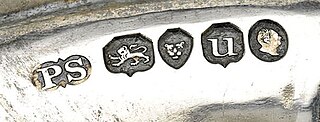
A mark is a written or imprinted symbol used to indicate some trait of an item, for example, its ownership or maker. Mark usually consists of letters, numbers, words, and drawings. Inscribing marks on the manufactured items was likely a precursor of communicative writing.

